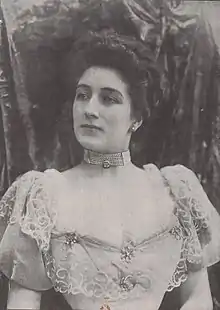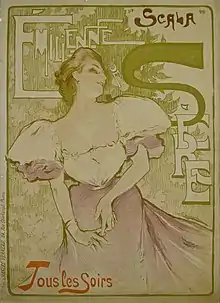
Émilienne de Sère was a French operetta and café-concert singer active from 1894 to 1904.
Life

Sère made her debut at the Menus-Plaisirs in the revue Que d'eau ! Que d'eau ! She then moved on to various other stages and sang in Parisian salons. She entered the Théâtre-Moderne, from where she left for Bucharest, where she was offered a favourable engagement. On her return, she stayed away from the theatre. Édouard Marchand hired her for the Trouville-sur-Mer Casino season, and the Scala (Paris) in 1895.[2][3]
She sang at the Casino de Paris in 1898[4] and created the role of Thaïs in the bouffe fantasy Othello chez Thaïs[5] at the Bouffes de Bordeaux the same year.[6]
She performed at the Alcazar de Bruxelles[note 1][7] and at the Salone Margherita (Napoli) in Naples[8] in 1899,[9] at the Театр Омона in Moscow in 1900[10] at the Alcazar of Marseille in 1901[11][12] in Roma[13] in Naples[14] at the Kursaal[15] or "Nouveau-Théâtre" in Geneva[16][17] at the Palace Theatre, London in 1902, then in Düsseldorf, Berlin and Vienna[18] and at the Central-Theatre in Leipzig in 1903.[19]
She led the revue Bruxelles ! tout le monde… monte, at the Cirque Royal in Brussels for 3 months in 1904.[20][21] She performed again at the London Palace Theatre in 1904.[22]
References
- ↑ Alcazar royal or Fantaisies-Parisiennes
- ↑ "Le Mondain". Gallica (in French). 22 December 1894. Retrieved 12 May 2021.
- ↑ "Le Mondain". Gallica (in French). 1894-12-22. Retrieved 12 May 2021.
- ↑ "Le XIXe siècle". Gallica (in French). 31 August 1895. Retrieved 12 May 2021.
- ↑ "Le Figaro". Gallica (in French). 1898-04-14. Retrieved 12 May 2021.
- ↑ Berthelot, P.; Roland, Claude. Othello chez Thaïs (in French). Retrieved 12 May 2021.
- ↑ "Gil Blas". Gallica (in French). 1898-10-14. Retrieved 12 May 2021.
- ↑ "Gil Blas". Gallica (in French). 1899-04-28. Retrieved 12 May 2021.
- ↑ A. Pesce; M. Stazio (2013-12-18). La canzone napoletana. Tra memoria e innovazione (in Italian). CNR. Istituto di Studi sulle Società del Mediterraneo. p. 472. ISBN 978-88-909500-0-1. Retrieved 12 May 2021.
- ↑ "Gil Blas". Gallica (in French). 1899-12-08. Retrieved 12 May 2021.
- ↑ "Gil Blas". Gallica (in French). 1900-01-19. Retrieved 12 May 2021.
- ↑ "Littoral-mondain". Gallica (in French). 1901-09-14. Retrieved 12 May 2021.
- ↑ "Gil Blas". Gallica (in French). 1901-09-15. Retrieved 12 May 2021.
- ↑ "Gil Blas". Gallica (in French). 1901-11-11. Retrieved 12 May 2021.
- ↑ "Gil Blas". Gallica (in French). 1902-03-20. Retrieved 12 May 2021.
- ↑ "Kursaal de Genève, Geneva — Theaterlexikon". tls.theaterwissenschaft.ch. Retrieved 12 May 2021.
- ↑ "Gil Blas". Gallica (in French). 1902-06-21. Retrieved 12 May 2021.
- ↑ "Le Figaro". Gallica (in French). 1902-06-25. Retrieved 12 May 2021.
- ↑ "Le Figaro". Gallica (in French). 1902-11-18. Retrieved 12 May 2021.
- ↑ "Le Figaro". Gallica (in French). 5 February 1903. Retrieved 12 May 2021.
- ↑ "Le Monde artiste". Gallica (in French). 17 January 1904. Retrieved 12 May 2021.
- ↑ "La Lanterne". Gallica (in French). 1904-04-26. Retrieved 12 May 2021.
- ↑ "Gil Blas". Gallica (in French). 16 November 1902. Retrieved 12 May 2021.